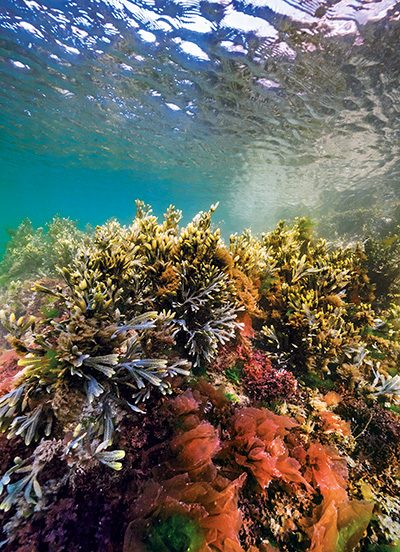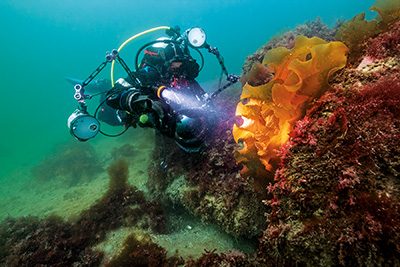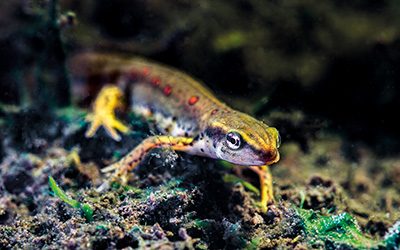LOCAL DIVING
BETWEEN NEW YORK AND BOSTON LIES HARTFORD, the heartbeat of Connecticut. Visitors there can tour the Mark Twain House, Harriet Beecher Stowe Center, and the Wadsworth Atheneum Museum of Art. Beyond the city, trees and hills make way for fresh and coastal waters teeming with macro life.
The northeast is so dense and diverse that I visited five states on my first trip, so no dive site there is too far to reach. All dive sites in Connecticut are within an hour’s drive of Hartford, but divers from across the region travel to its coastal waters to get their weekend dive fix.
Connecticut’s shores are economically appealing and easy to access — all you need is a buddy and dive gear. No schedule dictates when you must leave shore, and there are no costly boat fees. The macro life is surprisingly rich, so you can spend many hours photographing a variety of smaller subjects. Some wide-angle opportunities are possible when the water is at its clearest in early spring and during calm weather.
The Gulf Stream rushes into the coastal area between Rhode Island and Connecticut, bringing with it tropical life during the summer. Renowned Rhode Island dive site Fort Wetherill sits directly across from Connecticut’s Stonington Point, and they share the same wildlife and easy access to the shore.
Diving Bigelow Pond on the north side of the state allows divers to avoid questionable weather and currents. Tiny newts near the shoreline are the highlight, and rich soil gives the water a tannic color. Other freshwater destinations, such as Brownstone Quarry, are filled with sunken attractions.



Stonington Point
Stonington is often considered one of the prettiest coastal towns in New England. The rich marine environments of Fort Weatherill and Stonington Point are only 30 miles apart. Good weather helps provide calm seas, which is important because this site is less protected than the bays of Fort Wetherill. Stonington Point is a more surprising destination, however, because its open shoreline encourages marine life to come nearshore.
Even in windy weather, the sandy entry at the beach allows for easy access from Stonington Point, but it does reduce visibility. Protected by jetties, the shoreline gently slopes down to 20 feet. A boulder field harbors seaweed, kelp, and crabs on one side of the left jetty. The beach entry is between the other side of the left jetty and another one. Public parking is free but limited, so arrive early on weekends. Dive during slack tide, and head to the right from the beach to avoid currents.
Juvenile fish such as black sea bass congregate in the sand, while sugar kelp can grow along the jetty boulders or on the seafloor during spring and summer. Sugar kelp is a harvested food in Connecticut as part of the fastest-growing aquaculture in the country.


Local divers often observe dogfish at dusk but watch for winter skates and other rays, octopuses, and horseshoe crabs. Even lobsters, sea ravens, and nudibranchs are sometimes visible. Although numerous crab species scuttle along the bottom, horseshoe crabs are in the Arthropoda phylum and are not crabs. They are closely related to spiders and come ashore during mating season in the spring. Like spiders, horseshoe crabs have eight legs underneath their shells.
Horseshoe crab females are larger than males and can reach up to 19 inches in length, making them a wide-angle subject that is challenging to shoot. The compound eye on top of the shell is like a black abyss, and marine life grows on the shell’s exterior.
The largest of Connecticut’s shoreline parks is Hammonasset Beach State Park, but it is not a popular dive spot due to the exposed shoreline and the low visibility near the dive area.
Two maritime museums distinguish Stonington Point: the Mystic Seaport Museum and the Submarine Force Museum in Groton, which houses turn-of-the-century sailing vessels, modern submarine designs, and even a Navy SEAL transport vessel. The first nuclear submarine, the USS Nautilus, is permanently docked here and coincides with an exhibit that explains how Admiral Hyman G. Rickover helped create the nuclear Navy. The museum also features David Bushnell’s Turtle (the first submersible vessel used in combat), submarine escape suits, and a mixed-gas Mark V dive helmet.

An aerial shot of Bigelow Pond overlooks the dive area.
Bigelow Hollow State Park
This freshwater destination is an unlikely source for macro photography and general exploration. It boasts the advantages of inland waterways, which are less subject to weather changes, but visibility is best when it has not recently rained. The seasonal vernal pools throughout the park are complex habitats filled with lily pads.
The central waterway in the park is Bigelow Pond, which seems like a misnomer owing to its 18-acre area. Although it is shallow, the pond meets the definition of a lake.
This state park is one of the largest continuous forests in Eastern Connecticut, which is necessary for some of the aquatic life that depends on the deciduous and coniferous forest to reproduce.
Although nonresidents must pay a parking fee, the park otherwise has no other cost and features amenities such as bathrooms. The most popular dive site is between the public boat ramp and the picnic area. The picnic area is a 10-minute hike from the parking lot and down the trail next to the boat ramp. Bring a cart to reach an easy shore entry that leads to depths up to 50 feet.
Look for red-spotted newts, 3-inch to 5-inch macro subjects, in the shallow water at the shoreline. I can never travel far because the newts stop me before I reach deeper than 15 feet. Newts are salamanders, but not all salamanders are newts. Juvenile newts, called efts, live on land for one to three years after being born in the water before returning underwater for their adult lives. They also change their color from bright red-orange to a greenish hue with red spots. These newts secrete a poison on their skin, making them unpalatable for fish and dangerous to touch.
The bottom is very sandy, so keep your fins off the bottom to preserve visibility, although the particulates are heavy and will settle back down. Boulders along the shoreline add interest underwater and make a good reference point for navigation. The three parking areas around Bigelow Pond are dive sites with shore access and feature similar underwater topography and wildlife.
Brownstone Quarry
This quarry once supplied brownstone for local building materials before its modern use for recreational activities. The quarry closed in the late 1930s after a flood and a subsequent hurricane filled it with water. Springs continuously fill the quarry, making it impossible to remove the water. Brownstone Quarry recently regained popularity, contributing to interest and reopening some quarries on this 42-acre property.
Brownstone Quarry is best known as a water adventure sports park, and scuba diving is available in an area filled with sunken attractions such as speedboats. The deepest and clearest water is closest to the far quarry wall, and a navigation tour is available near the shore for divers. This dive site requires a park pass and reservation and is accessible to certified divers with buddies. This destination can become so busy that it sells out of park passes, so advanced reservations are recommended.
The attractions, which include underwater objects such as boats and platforms, are often covered in algae but make a good navigational tour in Brownstone Adventure Sports Park. Since this is a brownstone quarry, the stone walls reflect little light and give the water a dark appearance. The park also offers zip lines and paddleboarding. AD
How To Dive It
Kondisi: Spring to early fall offers the best conditions for diving, with warmer temperatures bringing richer marine life. Consider wearing exposure protection for temperatures around 40°F (4.4°C) at depth to 70°F (21°C) at the surface during summer. Visibility is fair at all dive sites — varying from 5 to 20 feet in Bigelow Pond to 5 to 30 feet on the coastline — but it’s enough for enjoying wildlife experiences. Dive flags are required at all sites in Connecticut, and diving is generally not allowed near boat ramps. Bring all your dive equipment, including breathing gas, to the dive sites. No on-site dive services are available at any of these dive sites.
Dive support: Although the sites are publicly accessible and easy to dive with a buddy, visit a dive shop or contact SECONN, the largest dive club in New England, to arrange a guide and check local conditions. SECONN holds an annual event at Mystic Seaport and organizes geocaching dives. The coast of Connecticut has other dive sites, but it’s best to visit them with a local expert to ensure all divers understand the safety issues and local regulations.
© Penyelam Siaga — Q4 2023